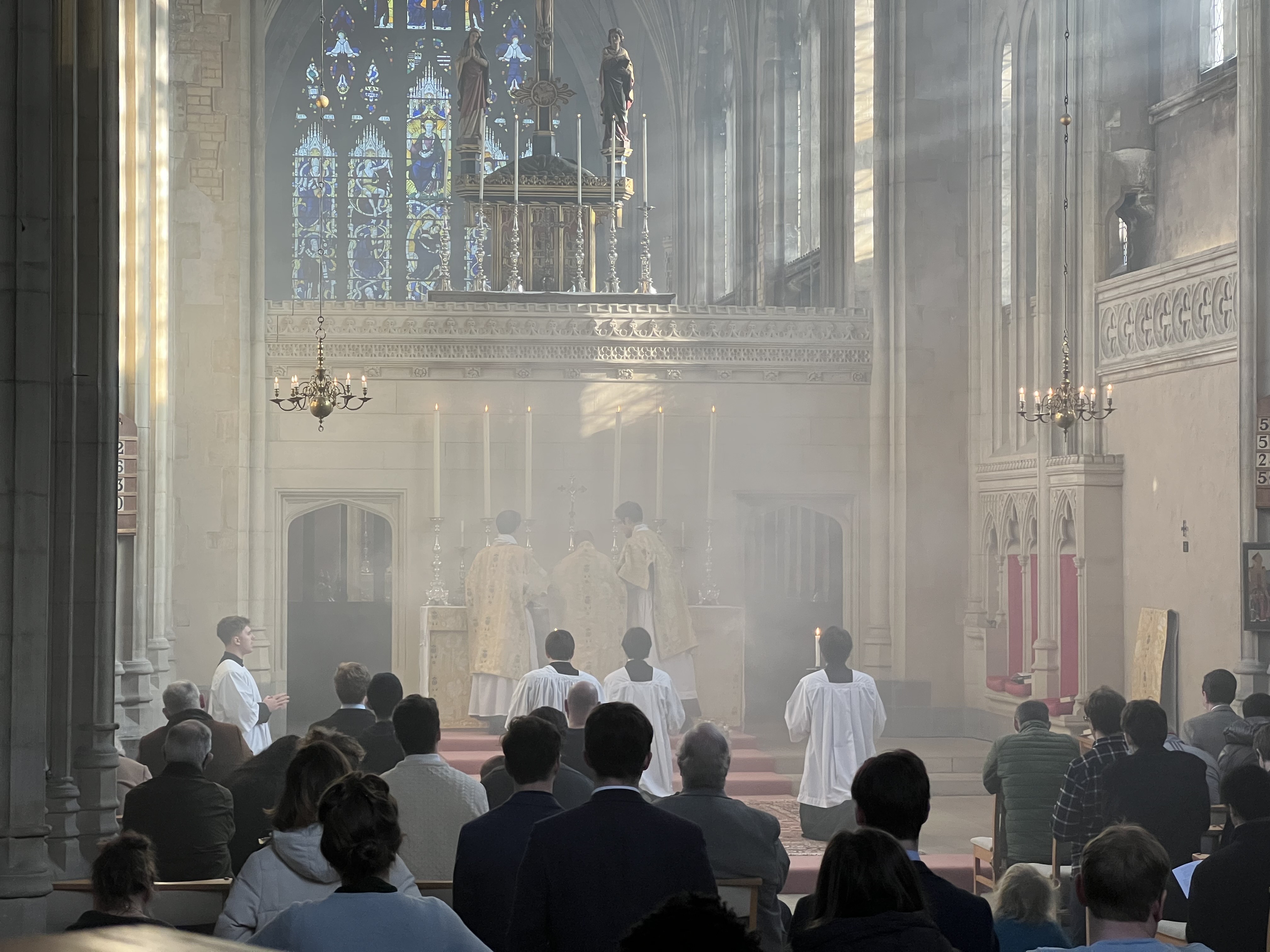|
Intercession
Intercession or intercessory prayer is the act of prayer, praying on behalf of others, or Intercession of saints, asking a saint in heaven to pray on behalf of oneself or for others. The Apostle Paul's exhortation to Saint Timothy, Timothy specified that intercession prayers should be made for all people. Christianity In the early Church The early Christians continued to practice intercessory prayer on behalf of others after Jesus' death. Ignatius of Antioch was one man who exhorted Christians to continue to pray for others, and especially for those who became Docetism, Docetists or held other heresy, heretical beliefs. In his Letter to the Smyrnaeans, letter to the churches of Smyrna, St. Ignatius exhorts the Christians there to pray for other people: "only you must pray to God for them, if by any means they may be brought to repentance, which, however, will be very difficult. Yet Jesus Christ, who is our true life, has the power of [effecting] this". Throughout all of Ignatiu ... [...More Info...] [...Related Items...] OR: [Wikipedia] [Google] [Baidu] |
Intercession Of Saints
The intercession of saints is a Catholic doctrine that maintains that saints can intercession, intercede for others. To intercede is to go or come between two parties, to plead before one of them on behalf of the other. In ecclesiastical usage both words are taken in the sense of the intervention primarily of Christ, and secondarily of the Mary, mother of Jesus, Blessed Virgin and the angels and saints, on behalf of men. The doctrine is held by the Catholic Church, Catholic, Eastern Orthodox, Eastern Orthodox Churches, the Assyrian Church of the East, the Oriental Orthodox churches, and some Lutherans and Anglicans (chiefly those of Evangelical Catholic or Anglo-Catholicism, Anglo-Catholic churchmanship, respectively). The practice of asking saints for their intercession can be found in Catholic writings from the 3rd century onwards. The 4th-century Apostles' Creed states belief in the communion of saints, which certain churches interpret as supporting the intercession of saints. ... [...More Info...] [...Related Items...] OR: [Wikipedia] [Google] [Baidu] |
Saints
In Christian belief, a saint is a person who is recognized as having an exceptional degree of holiness, likeness, or closeness to God. However, the use of the term ''saint'' depends on the context and denomination. In Anglican, Oriental Orthodox, and Lutheran doctrine, all of their faithful deceased in Heaven are considered to be saints, but a selected few are considered worthy of greater honor or emulation. Official ecclesiastical recognition, and veneration, is conferred on some denominational saints through the process of canonization in the Catholic Church or glorification in the Eastern Orthodox Church after their approval. In many Protestant denominations, and following from Pauline usage, ''saint'' refers broadly to any holy Christian, without special recognition or selection. While the English word ''saint'' (deriving from the Latin ) originated in Christianity, historians of religion tend to use the appellation "in a more general way to refer to the state of special ... [...More Info...] [...Related Items...] OR: [Wikipedia] [Google] [Baidu] |
Christian Prayer
Christian prayer is an important activity in Christianity, and there are several different forms used for this practice. Christian prayers are diverse: they can be completely spontaneous, or read entirely from a text, such as from a breviary, which contains the canonical hours that are said at fixed prayer times. While praying, certain gestures usually accompany the prayers, including folding one's hands, Bowing#Christianity, bowing one's head, kneeling (often in the kneeler of a pew in corporate worship or the kneeler of a prie-dieu in private worship), and Prostration#Christianity, prostration. The most prominent prayer among Christians is the Lord's Prayer, which according to the gospel accounts (e.g. wikisource:Bible (American Standard)/Matthew#6:9, Matthew 6:9-13) is how Jesus in Christianity, Jesus taught his Disciple (Christianity), disciples to pray. The injunction for Christians to pray the Lord's Prayer thrice daily was given in ''Didache'' 8, 2 f., which, in turn, was ... [...More Info...] [...Related Items...] OR: [Wikipedia] [Google] [Baidu] |
Christian Doctrine
Christian theology is the theology – the systematic study of the divine and religion – of Christianity, Christian belief and practice. It concentrates primarily upon the texts of the Old Testament and of the New Testament, as well as on Christian tradition. Christian theologians use biblical exegesis, rationality, rational analysis and argument. Theologians may undertake the study of Christian theology for a variety of reasons, such as in order to: * help them better understand Christian tenets * make comparative religion, comparisons between Christianity and other traditions * Christian apologetics, defend Christianity against objections and criticism * facilitate reforms in the Christian church * assist in the evangelism, propagation of Christianity * draw on the resources of the Christian tradition to address some present situation or perceived need * education in Christian philosophy, especially in Neoplatonism, Neoplatonic philosophyLouth, Andrew. The Origins of the Ch ... [...More Info...] [...Related Items...] OR: [Wikipedia] [Google] [Baidu] |
Anglo-Catholicism
Anglo-Catholicism comprises beliefs and practices that emphasise the Catholicism, Catholic heritage (especially pre-English Reformation, Reformation roots) and identity of the Church of England and various churches within Anglicanism. Anglo-Catholicism claims to restore Christian liturgy, liturgical and Anglo-Catholic devotions, devotional expressions of church life that reflect the ancient practices of the early and medieval church. The term was coined in the early 19th century, although movements emphasising the Catholic nature of Anglicanism already existed. Particularly influential in the history of Anglo-Catholicism were the Caroline Divines of the 17th century, the Jacobitism, Jacobite Nonjuring schism of the 17th and 18th centuries, and the Oxford Movement, which began at the University of Oxford in 1833 and ushered in a period of Anglican history known as the "Catholic Revival". History The historic Anglican formularies, developed under the influence of Thomas Cranme ... [...More Info...] [...Related Items...] OR: [Wikipedia] [Google] [Baidu] |
Anglican
Anglicanism, also known as Episcopalianism in some countries, is a Western Christianity, Western Christian tradition which developed from the practices, liturgy, and identity of the Church of England following the English Reformation, in the context of the Protestant Reformation in Europe. It is one of the largest branches of Christianity, with around 110 million adherents worldwide . Most are members of national or regional Ecclesiastical province#Anglican Communion, ecclesiastical provinces of the international Anglican Communion, one of the largest Christian bodies in the world, and the world's third-largest Christian communion. When united and uniting churches, united churches in the Anglican Communion and the breakaway Continuing Anglican movement were not counted, there were an estimated 97.4 million Anglicans worldwide in 2020. Adherents of Anglicanism are called ''Anglicans''; they are also called ''Episcopalians'' in some countries. The provinces within the Anglican ... [...More Info...] [...Related Items...] OR: [Wikipedia] [Google] [Baidu] |
Martyrdom
A martyr (, ''mártys'', 'witness' stem , ''martyr-'') is someone who suffers persecution and death for advocating, renouncing, or refusing to renounce or advocate, a religious belief or other cause as demanded by an external party. In colloquial usage, the term can also refer to any person who suffers a significant consequence in protest or support of a cause. In the martyrdom narrative of the remembering community, this refusal to comply with the presented demands results in the punishment or execution of an individual by an oppressor. Accordingly, the status of the 'martyr' can be considered a posthumous title as a reward for those who are considered worthy of the concept of martyrdom by the living, regardless of any attempts by the deceased to control how they will be remembered in advance. Insofar, the martyr is a relational figure of a society's boundary work that is produced by collective memory. Originally applied only to those who suffered for their religious beliefs, ... [...More Info...] [...Related Items...] OR: [Wikipedia] [Google] [Baidu] |
Shrine
A shrine ( "case or chest for books or papers"; Old French: ''escrin'' "box or case") is a sacred space">-4; we might wonder whether there's a point at which it's appropriate to talk of the beginnings of French, that is, when it wa ...: ''escrin'' "box or case") is a sacred space dedicated to a specific deity, ancestor worship, ancestor, hero, martyr, saint, Daemon (mythology), daemon, or similar figure of respect, wherein they are venerated or worshipped. Shrines often contain Cult image, idols, relics, or other such objects associated with the figure being venerated. A shrine at which votive offerings are made is called an altar. Shrines are found in many of the world's religions, including Christianity, Islam, Hinduism, Buddhism, Chinese folk religion, Shinto, indigenous Philippine folk religions, and Germanic paganism as well as in secular and non-religious settings such as a war memorial. Shrines can be found in various settings, such as churches, temples, cemeteries, or ... [...More Info...] [...Related Items...] OR: [Wikipedia] [Google] [Baidu] |
Martyrdom Of Polycarp
''Martyrdom of Polycarp'' (latin: ''Martyrium Polycarpi'') is a manuscript written in the form of a letter that relates the religious martyrdom of Polycarp, Bishop of Smyrna (the site of the modern city of İzmir, Turkey) in the 2nd centuryAD. It forms the earliest account of Christian martyrdom outside of the New Testament. The author of ''Martyrdom of Polycarp'' is unknown, but it has been attributed to members of the group of early Christian theologians known as the Church Fathers. The letter, sent from the church in Smyrna to another church in Asia Minor at Philomelium, is partly written from the point of view of an eye-witness, recounting the arrest of the elderly Polycarp, the Romans' attempt to execute him by fire, and subsequent miraculous events. The letter takes influence from both Jewish martyrdom texts in the Old Testament and the Gospels. Furthermore, the ''Martyrdom of Polycarp'' promotes an ideology of martyrdom, by delineating the proper conduct of a martyr. Con ... [...More Info...] [...Related Items...] OR: [Wikipedia] [Google] [Baidu] |
First Epistle Of Clement
The First Epistle of Clement () is a letter addressed to the Christians in the city of Corinth. The work is attributed to Clement I, the fourth bishop of Rome and was almost certainly written by him. Based on internal evidence some scholars say the letter was composed some time before AD 70, but another common time given for the epistle's composition is at the end of the reign of Domitian (c. AD96).Harris p. 363 As the name suggests, a Second Epistle of Clement is known, but this is a later work by a different author. The letter is a response to events in Corinth, where the congregation had deposed certain bishops. The author called on the congregation to repent, to restore the bishops to their position, and to obey their superiors. He said that the Apostles had appointed the church leadership and directed them on how to perpetuate the ministry. In Corinth, the letter was read aloud from time to time. This practice spread to other churches, and Christians translated it from ... [...More Info...] [...Related Items...] OR: [Wikipedia] [Google] [Baidu] |
Sacramentary Of Serapion Of Thmuis
The ''Sacramentary'' of Serapion of Thmuis is a work of Saint Serapion (fl. ca. 330 to 360, feast day: March 21), bishop of Thmuis (today Tell el-Timai) in the Nile Delta and a prominent supporter of Athanasius in the struggle against Arianism. He is sometimes called Serapion the Scholastic for his learning. He is best known in connection with this prayer-book or sacramentary ( euchologion) intended for the use of bishops. The sacramentary includes the earliest recorded use of the Sanctus.''Perspectives on Christian Worship'' by J. Matthew Pinson, Timothy Quill, Ligon Duncan and Dan Wilt (Mar 1, 2009) pages 64-65 Sacramentary This sacramentary, contained in a collection of Egyptian documents in an 11th-century manuscript at the Great Lavra on Mount Athos, was published by A. Dmitrijewskij in 1894, but attracted little attention until independently discovered and published by G. Wobbermin in 1899. It is a celebrant's book, containing thirty prayers belonging to the Divine Lit ... [...More Info...] [...Related Items...] OR: [Wikipedia] [Google] [Baidu] |







